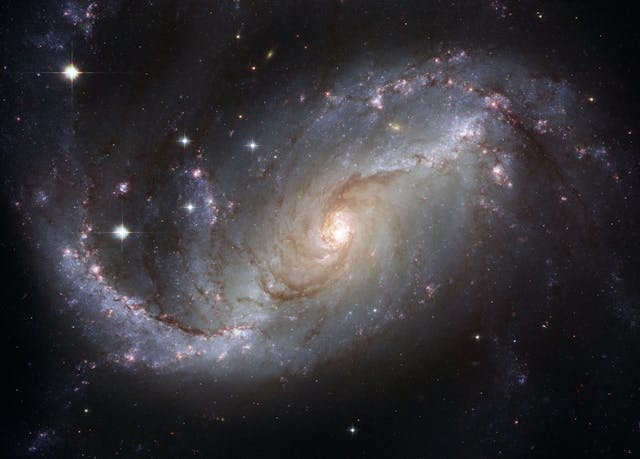
Why do stars ignite? Stars ignite when a cloud of gas and dust forms a big enough mass where the gravity creates enough pressure for nuclear fusion to start.
Stars form out of masses of gas and dust that are floating around in the universe. These gases and dust slowly bump into each other and clump together. As they get bigger, they attract more gas and dust. The bigger the accumulating cloud gets, the more matter it attracts, and this continues as they accrete matter. This growing cloud spins, depending on which way the gas was moving when it started to accrue. As the mass of matter gets bigger, it pulls in more matter from the outside and starts to spin faster. This is called the conservation of angular momentum, and it is why ice skaters spin faster when they draw their arms in close to their bodies.
The growing ball of gas and matter begins to get denser, and its gravity increases. The gas is mostly hydrogen because hydrogen is the most common element in the universe. 74% of the mass of the universe is made of hydrogen. As the gravity increases, the pressure in the center of the ball of gas increases as well. This increasing pressure pushes the hydrogen molecules closer together, and this is where the ignition comes from.
All of the atoms in the world around us are moving around depending on how much energy they have. They never come together because they are kept apart by a force called the Coulomb barrier. The nuclei of all atoms are positively charged because they contain positively charged protons and neutral neutrons. As we all know, opposite charges attract each other and like charges repel each other. This is the same as when you have two magnets and try to push the north and north ends together. They will be pushed apart by an invisible force. You will also know that if you push the magnets harder, you can overcome that force and bring them together. If the magnets are stronger, you just need more power to bring them together. You also know that when you let go of the magnets, they will spring apart again. The only way to keep the two magnets together is to use enough power that they fuse. This is what happens in a star.
As the cloud of gas gets larger, the gravity increases, and the pressure in the center forces the hydrogen atoms together. When the gravity and the pressure are high enough, the hydrogen atoms are pressed together with enough power to overcome the Coulomb barrier, and they fuse together. When four hydrogen atoms are fused together, the hydrogen nuclei combine to make a larger helium nucleus. Atoms are weighed in atomic mass units. A hydrogen atom is 1.00784 u and a helium atom is 4.002602 u. If you put four hydrogen atoms together, you get 4.03136 u. The difference between this and the 4.002602 u of a helium atom is released as energy, which is where the sun’s heat comes from.
Jupiter is made mostly of hydrogen, but it hasn’t started to ignite and become a star. To start nuclear fusion, you need a certain amount of mass or the gravity isn’t high enough to make enough pressure to fuse the atoms. It is generally thought that a star needs to be about 13 times the size of Jupiter, although stars about 3 times larger have been found. Jupiter, despite being massive, only has a volume 1,000 times that of the sun. The center of Jupiter is still very hot. It is probably about 24,000 ℃, and the hydrogen has been compressed into a metallic liquid, but nuclear fusion cannot start.
If Jupiter were larger, it could become a brown dwarf. A brown dwarf is a gas giant that starts nuclear fusion but doesn’t have enough mass to continue it. They are massive, and that alone creates a lot of heat, but not on the same level of a star. They are able to convert deuterium into Helium-3, but they cannot sustain that for very long because they very quickly run through their deuterium. Then, over time, they gradually cool down, releasing this heat energy as infrared light, which means they do glow, just not with the same brightness as a star. There are probably an enormous number of brown dwarfs in the universe, but we cannot see them because they don’t glow enough. And this is what I learned today.
Sources
https://science.nasa.gov/universe/stars/
https://en.wikipedia.org/wiki/Stellar_evolution
https://en.wikipedia.org/wiki/Nuclear_fusion
https://www.sciencefocus.com/space/is-it-possible-for-a-gas-giant-like-jupiter-to-ignite
https://spaceplace.nasa.gov/jupiter/en
https://www2.lbl.gov/abc/wallchart/chapters/10/0.html
https://www.skyatnightmagazine.com/news/smallest-star-can-be-webb-ic-348
https://simple.wikipedia.org/wiki/Brown_dwarf
https://www.universetoday.com/articles/what-makes-brown-dwarfs-so-weird
Photo by Pixabay: https://www.pexels.com/photo/gray-and-black-galaxy-wallpaper-2150/
